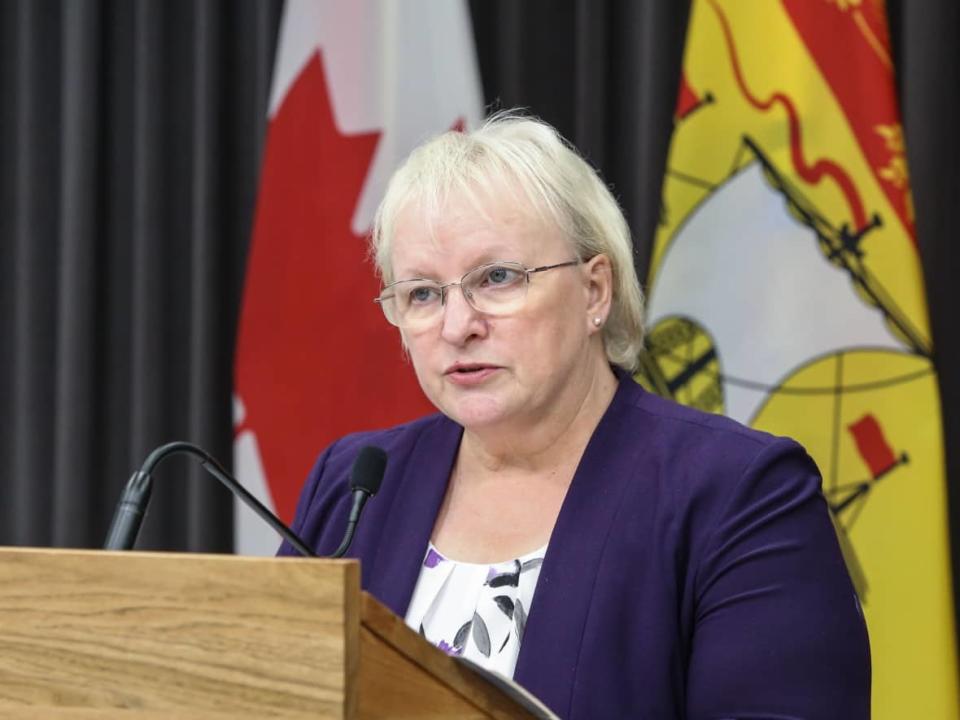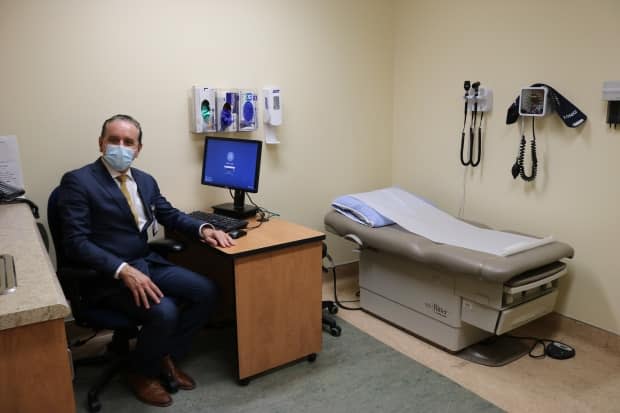Public Health now questioning 'validity' of New Brunswick's mystery brain disease

Public health officials in New Brunswick have "significant reason" to question the validity of a mystery brain disease they had earlier said affected dozens of people in the province, the province's health minister said on Wednesday.
That comes nearly eight months after the province raised red flags about a neurological illness that had affected a cluster of 48 people, including some as young as 18, primarily in the Moncton and Acadian Peninsula regions.
Reported symptoms ranged from balance issues and muscle spasms to behavioural changes and memory problems.
"Preliminary investigation conducted in late 2019/early 2020 determined this to be a distinct atypical neurological syndrome," a March 5 memo from the chief medical officer of health's office says.
A few days later, Chief Medical Officer of Health Jennifer Russell echoed the idea that it was something new and unknown.
"It most likely is a new disease," Russell said on March 18. "We haven't seen this anywhere else."
But now, the province is having doubts about the existence of the cluster, Health Minister Dorothy Shephard told reporters on Wednesday.
"During this investigation, we found gaps in the reporting process that allowed the situation to escalate often without oversight," she said.
But Alier Marrero, the neurologist who discovered the cluster and has treated most of the patients, is standing by his theory that his patients had an atypical neurological illness.
"We had three field epidemiologists working full time for three weeks each, for instance, besides having dozens of meetings with experts to analyze the data and to come up with the conclusion that there is a pattern here and that pattern is new," Marrero said in an interview with Radio-Canada.
Marrero said the findings weren't shared with him before they were announced publicly Wednesday.
Nine patients have died
Public health officials announced Wednesday that nine people from the cluster have died — one in 2019, four in 2020 and four this year.
But after studying the results of lengthy interviews with 34 members of the cluster, epidemiologists haven't been able to find any significant links between them, offering few answers for families who are wondering why their relatives suddenly became so ill, according to the report from Public Health.
"At this stage of the investigation, based on the current findings, there are no specific behaviours, foods, or environmental exposures that can be identified as potential risk factors with regard to this cluster of cases," the report says.
It says public health is still investigating the cluster "in order to determine whether the condition is an illness of unknown etiology, and if so, its potential causes, risk factors and prevention measures," the report says.
N.B. waited several months for autopsy results, minister says
The epidemiological findings come in the same month that new research was published on the Canadian Association of Neuropathologists website, concluding eight deceased members of the cluster did not die from something new and unknown.
An abstract of a presentation earlier this month at the association's annual meeting by Ottawa neuropathologist Gerard Jansen says eight people died from known illnesses such as cancer, Lewy body dementia and Alzheimer's disease. CBC News has not seen the full body of research.
"In these eight patients, no evidence for a prion disease was found, nor novel pathology," the abstract says.
"We suggest that these eight patients represent a group of misclassified clinical diagnoses."
Shephard, who acknowledged Jansen's findings at her press conference on Wednesday, told reporters that Public Health started asking for a status report on the autopsies beginning in February.
The autopsy results were presented to the province by Jansen at the end of August, she said.
But the minister said officials didn't receive a copy until Sept. 24.
Shepherd wrote a letter to federal Health Minister Jean-Yves Duclos on Wednesday, expressing concern about the delay.
"We have encountered challenges in undertaking our investigation," Shephard wrote in the letter, which was shared with CBC News by the provincial Department of Health.
"In particular, there has been a lack of timely access to information held by the CJD Surveillance System (CJDSS) about patients in New Brunswick. We have also had concerns about the CJDSS's over-reliance on the clinical validity of information received from individual physicians."
The Public Health Agency of Canada did not respond to a request for an interview about Shephard's comments on Wednesday.
Results of 2nd review expected in early 2022
The report released Wednesday is separate from a second investigation by an oversight committee, made up primarily of neurologists and set up by the government in June, that is also investigating the cluster. That committee is supposed to present its report early in 2022, according to Shephard.
"Neurologists are reviewing every case, and afterwards, they present to other neurologists the findings to get their comments and to discuss this within a group," said Dr. Natalie Banville, who co-chairs the committee and is also the vice-president of medical affairs Vitalité Health Network.
For Steve Ellis, who was told his father, Roger Ellis, is part of the cluster, it means waiting longer to know what has caused his 64-year-old father's debilitating symptoms.
He said he was hoping to hear more Wednesday about what the oversight committee has been doing.
"To hear that they won't be finished their reviews until early in 2022 felt like a slap in the face," Ellis said in an interview with CBC News.
Jill Beatty is also eagerly awaiting the results of that second review. Her father, Laurie Beatty, died of a neurological illness in 2019.
At first, doctors thought he had Creutzfeldt-Jakob Disease (CJD), a rare and fatal brain disease. But the autopsy results came back negative for CJD, and Beatty's family was later told he is part of the cluster.
After Wednesday's news, Beatty said her trust in Marrero and her father's medical team, who tested him extensively, has not wavered.

"We had to do a process of elimination," she told Radio-Canada.
"We knew exactly what he didn't have. But what he did have, to me, and to my family, that is still up in the air. That is why this second component is going to be so important."
No evidence that a particular food is linked
Wednesday's report included analysis of interviews provided by 34 people in the cluster, or in some cases their family members. Most of the patients (22) were in Zone 1 (the Moncton region) when they first got sick. Another eight people were in Zone 6 (the Bathurst and Acadian Peninsula regions) while two people were in Zone 2 (the Saint John region), one in Zone 7 (the Miramichi region) and one person in an area described as "other zones."
Nearly all of the people studied in the cluster reported eating lobster, with many (26) eating prawn or shrimp, scallops (26), mussels (18) or clams (17).
About half of the people studied reported eating moose meat caught or hunted from New Brunswick.
But the report concludes those factors aren't likely significant.
"These are typical of the region, which may be strongly influenced by Maritime cultural practices as well as the catchment area of the referring neurologists," the report says.
"There is no evidence from this report that a particular food, such as lobster, wild berries or moose, is linked to the development of neurological symptoms, as more cases would have been identified within the province and in neighbouring provinces and states."
The report also found 12 of the 34 people "had family members or close contacts who were experiencing similar symptoms," though it's not clear what the significance of that might be.
"These observations have not been validated by the Oversight Committee through clinical records and laboratory information," the report says.
Several had environmental exposures
Eight of the 34 people studied from the cluster reported "they may have been exposed to harmful algae blooms," the report says.
Twenty-five of the 34 people "reported industrial exposures in their work or living environments."
Twelve reported being "indirectly exposed to pesticides or herbicides in their environment, such as living near a commercial farm."
In the two years prior to getting sick, more than half said they'd spent time "gardening or working with soil at home in their community garden, nursery or farm," while two people reported direct exposures to pesticides, "having personally mixed, loaded, handled or applied pesticides in the two years prior to symptom onset."
"A full clinical and diagnostic review is being undertaken by the oversight committee for each case involved in this cluster, which will allow a more thorough analysis into these potential risks of exposure," the report says.
Earlier this year, Marrero said he suspected something environmental was causing patients' symptoms.
Neil Cashman, a neurologist and professor in the University of British Columbia's medical school, also told CBC News earlier that possible environmental toxins, such as blue-green algae, would be examined as part of the investigation.
Both Marrero and Cashman are no longer part of the province's investigation into the mystery illness and aren't part of the committee set up by Public Health. The government's committee also doesn't include any environmental experts.

